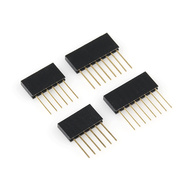blf wrote: Also, I don't see any info on how to power the ElSeq board.
The MCU on the board gets it's power from a separate (from the LM317) 3.3v regulator that gets it's power from either the battery connector or "USB-5V", aka the pin labelled 5v in the FTDI area. You select which is used via switch SW1.
The inverter
may get it's DC power from the board as discussed below;
R0B0T1CS | about 9 months ago * 1
Ckt Diagram indicates:
Batt Min is “4.8V if using LM317 regulator at default 3.3V DC out to iverter”
This page indicates:
“Can be powered by a 3.7V Lipo battery (using 3V inverter), or an external 3.3V to 16V supply (using 3V or 12V inverter)”
Which is it? If it does in fact require >3.7V, please use a Vreg with lower dropout on the next revision!
Also, why do both this page and the ckt diagram suggest the use of the “5V FTDI BOB” when the microcontroller is run at 3.3V?
Which Should be used?
MikeGrusin | about 9 months ago * 2
It’s both. This board is pretty versatile, and can be reconfigured for various power sources and inverter choices.
If you wish to use a 5V-12V supply and the 3V inverter, the LM317 regulator will provide 3.3V for the inverter.
If you wish to use a 3.7V Lipo supply and the 3V inverter, you can bypass the LM317 regulator and send 3.7V straight to the inverter.
If you wish to use a 12V supply and the 12V inverter, you would also bypass the LM317 and send 12V straight to the inverter.
The tutorial at the top of this page has more information and a table of the various configurations you could use.
To answer your other questions:
The reason we’re using a 1.5V dropout regulator is that we wanted the inverter regulator to be able to handle up to 1.5A for very large inverters. As the inverter isn’t picky about the exact input voltage (e.g. the 3V inverter is quite happy running on a Lipo’s unregulated 3.7V), the extra expense of a high-current LDO wasn’t warranted.
The reason we spec’d a 5V FTDI on a 3.3V system, is that if you’re going to use the FTDI to power the board + inverter, the 5V FTDI can supply up to 500mA whereas the 3.3V FTDI can only supply 50mA.

